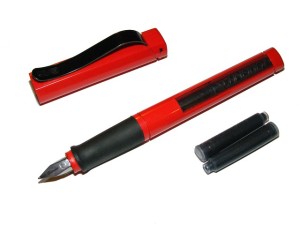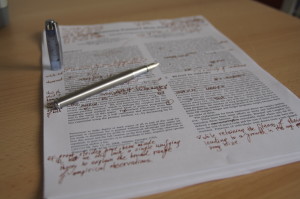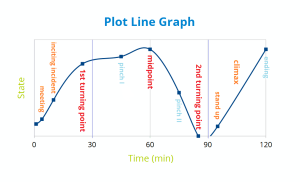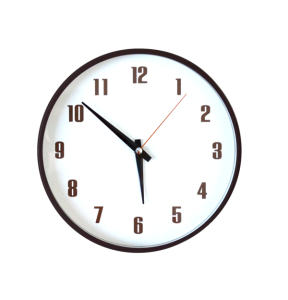Think its time to submit that story?
One night last month, you sat bolt upright in bed: an idea for a new story popped into your head. The idea was not just good, it was brilliant. If executed properly, you knew that this story would not only make a splash, it would go down in history as one of the decade’s finest literary achievements. 2015’s What We Talk About When We Talk About Love. Move over Ray, you thought.
This morning, you woke up at dawn, skipped your coffee, and knocked it out of the park. Now what? How do you know when it is time to submit and where?
Disclaimer: I’ve only had two pieces published, with a couple more forthcoming, but I’m going to share some of what I have learned from the many mistakes I have made. They might help you figure out when it is time to submit your next great piece and where.
Not yet time to submit: from first draft to final
If you are at all like me, your revising process is crucial. Most of us learned in school that the main difference between first and final draft is that the final draft has been proofread and formatted. These are important aspects of the revising process, but they are only the beginning. Just like spending too much time in front of the mirror will give you a skewed perception of your appearance, trying to revise immediately after finishing a first draft may give you the same result.

12 Pre-Submission Considerations
- Before I decide when to submit, I leave the story alone for a few days to a week, while I work on something else.
When you go back to it, you’ll find a fresh perspective. This will allow you to look at the piece a little more objectively.
- For my first round of revising, I like to print the first draft out and mark corrections in pen or pencil.
According to a 2013 article in Scientific American:
“Even so, evidence from laboratory experiments, polls and consumer reports indicates that modern screens and e-readers fail to adequately recreate certain tactile experiences of reading on paper that many people miss and, more importantly, prevent people from navigating long texts in an intuitive and satisfying way.”
In addition, screen reading may require more of our mental capacity and therefore make it harder to remember what we read. Simply being aware of this discrepancy may help mitigate the possible downsides of screen reading, but I still prefer a physical copy. Maybe I’m old fashioned.

- After my first round of revising/proofreading, I make the corrections and reread a second time.
Chances are, you won’t catch all your spelling and grammatical errors with just read –though, so do another just to be safe. For this second reading, I try to mimic the experience of the reader by reading the piece from beginning to end in one sitting (we’re talking short-stories here) After I make this second round of corrections, I usually feel comfortable sending the slightly less rough draft to a few trusted readers.
- At this stage, I only share my work with people who understand the revising process and know what to look for. If you have a writing group, this might be when you share a part of the piece, not the whole thing.

On his blog “The Write Practice” author Joe Bunting writes briefly on how to interpret comments you receive from your first readers.
- Before I consider when it is time to submit, I like to get specific feedback on my opening sentence.
This may seem like a small detail, but many editor interviews I have read tend to focus on this surprisingly important aspect of a short story. For the next round of revising, think about how the rest of the story lives up the promises made in the opening paragraphs.
If your experience is like mine, the first impressions of your first readers will be eye-opening.
Still, take these first impressions with a grain of salt when considering when to submit.
Think about how the impressions of your readers aligns with your vision for the piece as a whole. If they pick up something about the plot or a character that you never considered, think about whether or not you want to incorporate their thoughts into your rewrite.

- If the feedback I get is focused on minute details, I consider what this means for the overall arc of the story.
Sometimes, people will point out minute details because they are not sure what they are really supposed to get out of the piece. When this happens, consider adding more detail to make sure the reader understands what is going on.
I tend to believe that less is more when it comes to short fiction and articles. Decide what is crucial, and what can be left out.
- At this point, I try to eliminate all words and phrases that do not contribute stylistically, further the plot, or develop a character.
There may be nothing worse than reading pages of unnecessary back story or descriptions that don’t move the story along. If you cannot justify why an exposition or description is there, it may not be time to submit.

- I look for any clichés or stale language
I know I opened this post with a cliche, but for every one you write, there are millions of phrases that you can replace it with. Here is an example:
Cliché: The boy’s battered face caused long buried memories to well up inside him.
Rewrite 1: The boy’s battered face sent an Old Faithful of long buried memories gushing through his body.
Rewrite 2: The sight of the boy’s battered face sent a tremor of long buried memories through his body
If your piece is full of cliches, it may not be time to submit
- When I consider submitting a story, I do a little comparison between my finished piece and pieces by other authors that I really respect.
If you can honestly see your piece standing alongside pieces that you know are great, you are getting close. Reading editor interviews are incredibly helpful. Like this one with Deborah Treisman, fiction editor at The New Yorker.

Final draft and beyond: time to submit!
So it has been a couple weeks since you finished your final draft. You have proofread the piece, gotten feedback, and done a couple minor (or major) rewrites. Is it time to submit.
Maybe. How does this story rank compared to your other work?
- If it isn’t the best I’ve done, maybe its not ready
Editors read hundreds of well-written, compelling pieces every reading period. Will yours stand out? What are you offering that is different? If you can’t answer these questions, it may not be time to submit.
- My voice and my background are what set me apart from other writers. Will my story convince an editor that my voice belongs in their journal?
If the answer to the above question is yes, it may be time to submit. One very important question still remains:
- OK. I think it is time to submit. Where do I send it?
Hopefully, this post helped you decide when to submit your piece.

In my next post, I will present several questions I ask myself about my pieces that I think are ready to submit. The answers to these questions give a solid starting point for finding the right markets for your finished pieces.
When you decide on where to submit, carefully read all the submission guidelines in terms of formatting. In the absence of specific instructions, there are some rules to follow that should prevent you from offending anyone.
In the meantime, check out my first three posts in this series:

